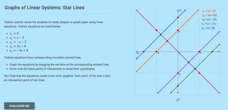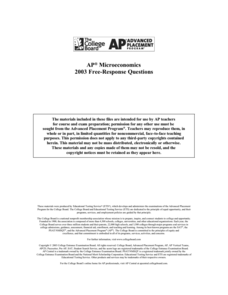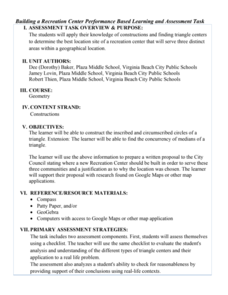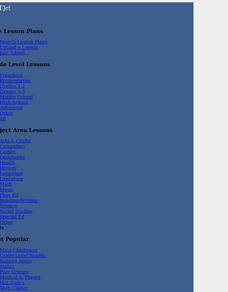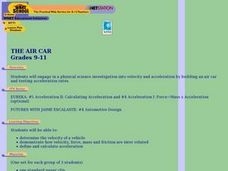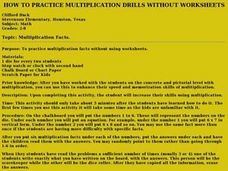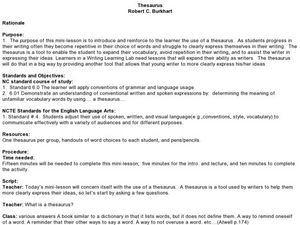CK-12 Foundation
Graphs of Linear Systems: Star Lines
Let the class stars shine. Using four given linear equations, scholars create a graph of a star. The pupils use the interactive to graph the linear systems and determine the points of intersection. Through the activity, classmates...
CK-12 Foundation
Ellipses: The Ellipse
Learners explore ellipses by changing the lengths and orientation of the major and minor axis. Using the interactive, they determine the equation of the ellipse and its eccentricity. Given an equation the scholars identify the center,...
US Holocaust Museum
Life in Shadows: Hidden Children and the Holocaust
Hiding in the filth of a sewer, as a child, to avoid capture by Nazi soldiers—sounds scary! Scholars investigate the youngest victims of the Holocaust, the children. They research video clips and written sources from the Holocaust...
NET Foundation for Television
1850-1874 African American Settlers
Go West, young man! Scholars investigate the impact of African American settlers moving to the Nebraska territory, following the passage of the Kansas-Nebraska Act in the mid 1800s. Using primary sources, timelines, maps, and...
PBS
Coastline Change
Continental drift happens over millions of years, but new perspective shows much faster changes. An informative resource offers a short term perspective using a series of satellite images. Viewers observe major changes to a coastline in...
College Board
Advanced Object-Oriented Concepts
Advance inheritance in the classroom. The resource is a professional development module with sections great to use in the classroom. Sections cover ideas of inheritance in Java along with abstract classes. Each section includes a...
College Board
2003 AP® Microeconomics Free-Response Questions
A company producing smoke alarms has a monopoly. However, what factors influence its profit and production? A series of prompts from College Board asks learners to consider the impact. Other practice problems include examining what...
College Board
2003 AP® Microeconomics Free-Response Questions Form B
How are monopolies and competitive firms similar and different? Scholars consider the question using authentic College Board materials. Other prompts consider supply and demand curves and the relationship between wages and output.
Radford University
Building a Recreation Center
It's all about location, location, location. Small groups work to find the best spot for a rec center to serve three different communities. Learners construct the inscribed and circumscribed circles of a triangle to find the best place....
American Battlefield Trust
Creating a Historic Site Lesson Plan
What makes a place historic? Using events from their own lives, learners consider this question, then deem places from their world historic. They then curate the experience for visitors, creating signs and other materials for their...
National Endowment for the Humanities
“From Time to Time”: Presidents and Communicating with the Public
While the Constitution requires a "State of the Union" address, it doesn't give many details. In fact, it wasn't until Woodrow Wilson that the periodic update to Congress was given in-person. Using primary sources, recordings and...
British Council
Drawing Dictation
Scholars give drawing dictations to practice using prepositions of place correctly. They work in groups, taking turn dictating and drawing. Learners then receive a picture they have not seen and write directions to accompany the image.
Curated OER
Around the Water Cycle--A Reader's Theater
Pupils read aloud a play script in a group to research the water cycle. They take the parts of raindrops. The amount of raindrops can be adjusted to fit group size.
Curated OER
The Air Car
Students, in groups, design and construct an air car capable of acceleration. They view a video on acceleration, test their cars and make adjustments as desired.
Curated OER
Measuring Techniques - Level II
Students identify appropriate abbreviations, food-measurement terminology, techniques, equivalents, calculate recipe-size adjustments, and demonstrate proper measuring techniques.
Curated OER
How to Practice Multiplication Drills Without Worksheets
Students practice their multiplication facts without the use of worksheets. They participate in an activity practicing their facts using a die. They record their progress and the game is adjusted as their level increases.
Curated OER
Ph-ocusing on Photosynthesis In and Out of the Garden
Young scholars are introduced to the concept of photosynthesis. As a class, they brainstorm a list of what they already know about plants and individually grow a plant on their own in the classroom. They record their observations...
Curated OER
The Cost of Smoking
Students explain the financial and life expectancy costs of smoking using a computer model to enter and adjust parameters to collect data in the form of a table. They analyze the data collected and determine the true cost of smoking.
Curated OER
Yeast Blowup
Students experiment to determine if yeast is a microorganism. In this yeast blowup lesson, students mix yeast with other ingredients and observe the results by using a balloon. Students adjust the amounts of the ingredients and test...
Curated OER
Fling It
Students investigate the best design using technology. In this science lesson, students construct a freestanding object with specific materials to be able to shoot a ping pong ball and a marshmallow. They have to adjust and...
Curated OER
Place Value: Making Change with Canadian Money
For this place value: making change with Canadian money worksheet, students use a spreadsheet and certain coins to practice and record how much change would be given from a $5 bill. A parent or tutor adjusts the questions to...
Curated OER
Thesaurus: Don't Be Repetitive
Learners use a thesaurus to expand their usage of language in their written work. In this thesaurus lesson, students work with the reference book to add variety to their word choices. Learners then adjust their spoken ,...
Curated OER
What is Life?
Students investigate living and non-living organisms/objects foudn around the school in this technology-based science activity. Adjustments to the activity can be made based upon technological limitations.
Curated OER
Catapults
Students are introduced to the concept of a catapult and how it is used with the help of a media presentation. They use catapults in a large, open area and record the distances objects travel. Students use the scientific method while...
